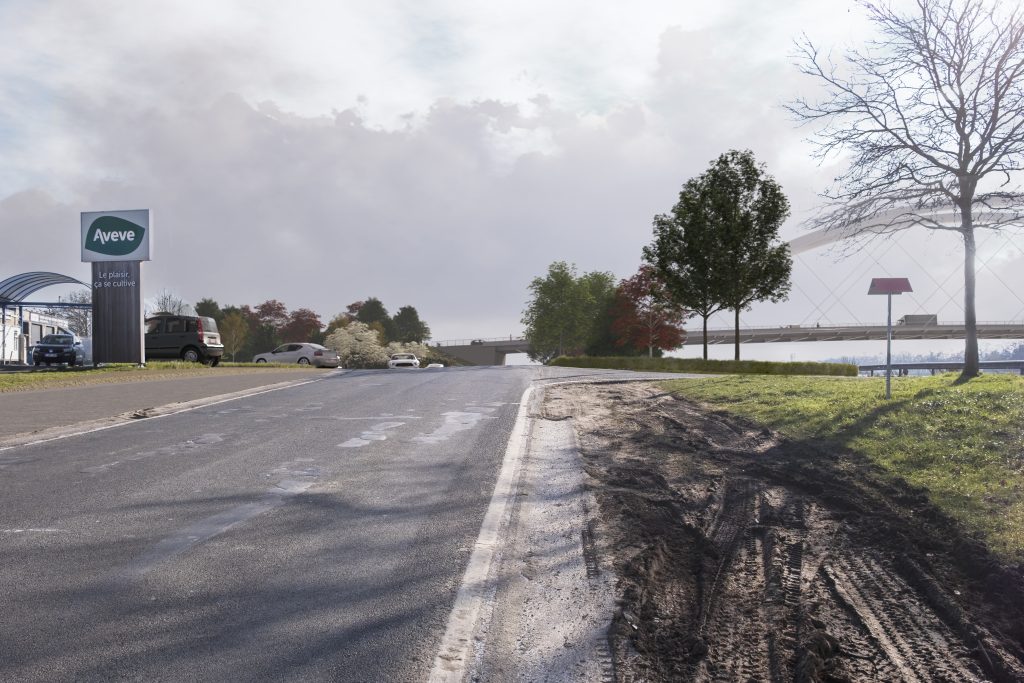From the 1980s bridges to today’s renewal
Designed in the 1980s, the Albert Canal bridges located in Lanaye, Lixhe, Hermalle, and Haccourt were entirely conceived and built by Bureau greisch. To meet the demands of modern navigation and allow the passage of vessels with greater clearance – increasing from 6.70 m to 8.80 m (for an available profile from 7.50 m to 9.10 m) – an in-depth study was carried out for each structure. The objective: assess the possibilities of raising the bridges and define the most suitable technical solutions and landscape arrangements, while also taking into account new uses, particularly for cyclists.
Haccourt: a complex project in a dense environment
The Haccourt bridge, a classic bow-string structure without approach spans, is relatively simple to raise from a structural standpoint, but its location is highly complex. Dense urban surroundings, adjacent roads, and significant current level differences require major adjustments. To reposition it, the bridge will be shifted southwards after removal of the nearby roundabout. This monumental 2,000-tonne relocation is part of a large-scale redevelopment project.
The entire area around the bridge is being reimagined: reallocated spaces, new road layouts, optimized connections, and cycle paths separated from motor traffic. Accessibility and safety are placed at the heart of the project. Two cycle tracks will be built on the bridge – a bidirectional one on the north side and a unidirectional one on the south side – and a new span will enable the road coming from Trilogiport to pass under the bridge while connecting logically with the quay. Finally, landscape improvements will soften the environment, contributing to a better local quality of life.
Hermalle: a facelift for a bow-string bridge
The bow-string bridge at Hermalle is being raised using telescoping towers. But beyond this technical operation, it is undergoing a full renovation: repairing concrete spalling, treating corrosion, applying new paint systems, replacing the deck waterproofing, and installing a redesigned drainage system.
Soft mobility is also a priority here. Although adding extra weight to the bridge is impossible, an ingenious solution has been adopted: the removal of the heavy 2 m-wide concrete sidewalk, replaced by a 4 m steel cantilever, keeping overall loads equivalent. This cantilever will host a grooved wooden deck, resin-coated and sandblasted with quartz, fixed every meter onto the steel frame to prevent lifting. This device allows the integration of a bidirectional cycle path. At the bridge exit, a separate cycle path ensures a smooth and safe transition, with a slope adapted to bicycle use.
Lixhe: pioneer of cable-stayed bridges
The Lixhe bridge is one of the very first cable-stayed bridges built in Belgium. At the time of its construction, the complex calculations for the stays were performed manually, which led to a limited number of supporting cables. To reduce interventions, only the right-bank side will be raised by 2.20 m, rotating around the support on the left bank. The chosen technique also involves telescoping each pier support, giving the deck an additional slope of 0.7%. Once the desired height is reached, the existing pier head will be hydro-demolished, preserving the reinforcement bars so they can be integrated with new reinforcement linking the extension to the original structure.
The integration of soft mobility is also essential. The four traffic lanes will be reduced to two, making room for a bidirectional cycle track and a ramp providing access to the RAVeL. These facilities will extend as far as the junction between the N617 and N602 and continue up to the roundabout at the Lixhe weir bridge, embedding the structure into a coherent active mobility network.
Lanaye: an almost compliant bridge
The Lanaye bridge already largely meets the new clearance requirements. Only additional safety measures are needed: specific signage will be installed to guarantee safe navigation. Moreover, particular attention has been given to soft mobility. The current markings will be replaced by a central-lane roadway (CVC), enabling cyclists to cross the bridge safely. The low intensity of local road traffic makes such a redesign possible without significant impact on motorized circulation.
- Client: SPW Voies hydrauliques
- Architect: Bureau greisch / Canevas
- Engineering Office: Bureau greisch



